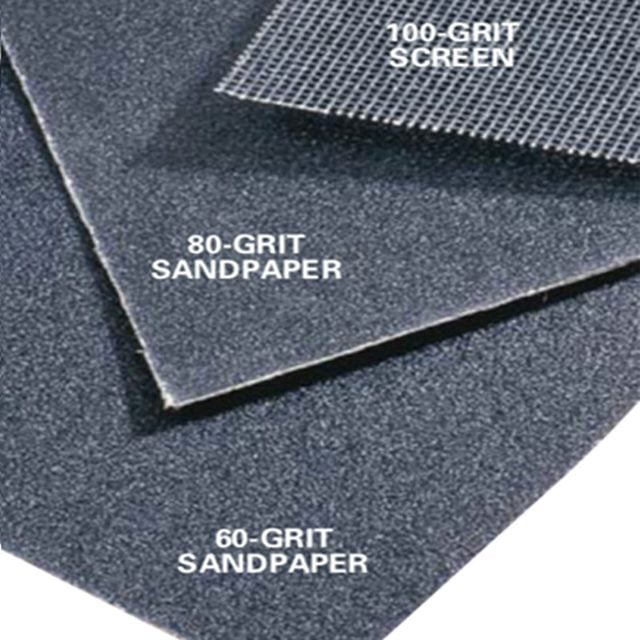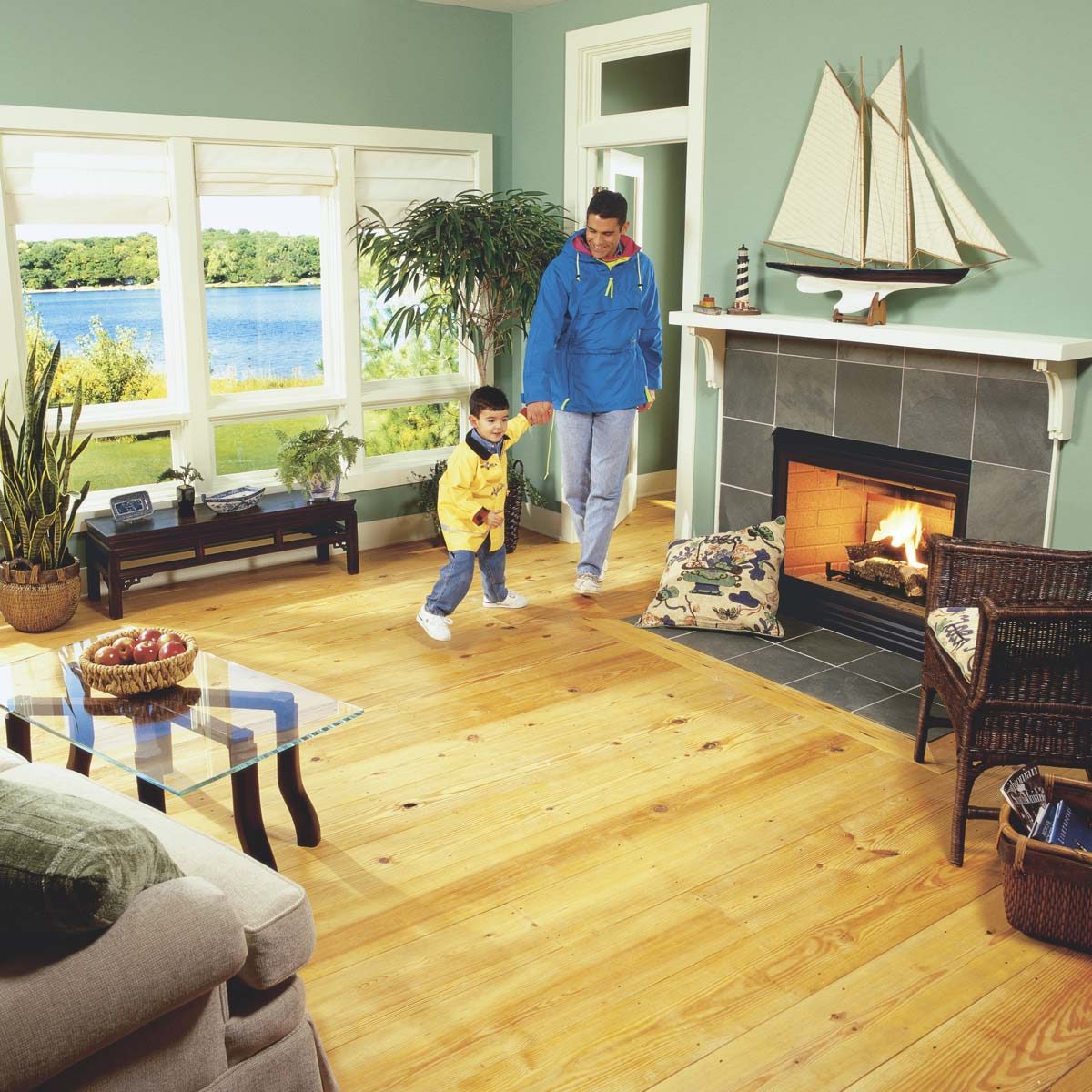Complete instructions for DIY installation of easy-care wide-plank pine flooring.
Multiple Days
Advanced
$501-1000
Introduction
If you love the look and feel of wood beneath your feet, wide-plank heart pine flooring is an exciting option. It cant quite transport you to the Old South, but a pine floor will transform your rooms with its soft patina and rich glow. It has two other plusses: Its easier to install than hardwood. You can skip the tricky sanding that goes along with an oak or maple floor. And it actually looks richer and more attractive as it ages. In this article, well show you how to choose and order your material, install it and finish it with our easy finish method.Tools Required
- Air powered flooring stapler
- Air-powered finish nailer
- Chalk line
- Circular saw
- Cordless drill
- Drill bit set
- Framing square
- Hammer
- Handsaw
- Jigsaw
- Nail set
- One-handed bar clamps
- Plastic shims
- Pry bar
- Router
- Slot-cutting router bit
- Stapler
- Table saw
- Tape measure
Materials Required
- 120-grit sandpaper
- 8d finish nails
- Cut nails
- Penetrating oil
- Pine flooring
- Rosin paper
- Wood putty
Shop for a pine style you love
Pine floors look even better as they age.

Pine floors are available in a variety of widths and grades. Longleaf Southern pine, or “heart pine,” is known for its dense, amber heartwood. It comes in a variety of widths and grades. It can be clear (knot-free) with a tight, straight grain, or it can include more character such as small or large knots. This 3/4-in. thick solid plank flooring is milled with a tongue and groove. The ends of boards can also have a tongue and groove. This feature is called end-matching. The joints between these boards can fall between joists, but you wouldn’t face-nail these ends. This would change the look somewhat.
Order a sample kit from a supplier to help choose the exact material you want. Prices vary depending on the pine’s source, grade and width, with the antique pine being the most expensive. We recommend material that requires little or no sanding.
We chose 10-in. wide, new heart pine with 50 to 80 percent heart content and without end matching. See “Pine Flooring Options” for more details.
Work through key layout details before getting started
Pine flooring cross section

The 3/4-in.-thick solid plank flooring shown is milled with a tongue and groove. The tongue-and-groove pine flooring must run perpendicular to the floor joists. To keep the wide boards from cupping, you’ll face-nail them with cut nails driven through the subfloor and into the joists (Photo 18). For the best results, draw the floor plan to scale and lay out rows of boards (Fig. A). Shift the layout as needed to avoid very narrow pieces at the walls or at other features like around the fireplace. Later you’ll transfer your plan to the floor and snap chalk lines at about 3-ft. intervals to keep the rows running straight.
Calculate the square footage of the room and add 10 to 15 percent to allow for selection and waste. It’s better to have a few leftover pieces than to pay the shipping for one or two additional boards. Also order the cut nails and the oil finish. The supplier will advise on the amounts needed. There may be an additional fee for shipping. Schedule delivery early so the flooring can acclimate indoors to your home’s moisture level. This is a very important step.Store the wood on location for at least 10 days. To keep wood floors stable, try to maintain close to 50 percent relative humidity in your home year-round.
Draw the room’s floor plan to scale.
- Draw the centerline of the room.
- Lay out the board runs using their actual width.
- The board at the wall should be at least half width. If necessary, shift the boards half a board width at the centerline.
- Avoid thin slivers. For example, note the notched board at the hearth.
Note: You can download and enlarge this plan by going to the Additional Information below.
Pine flooring options
You can buy heart pine flooring in a variety of widths and grades. Stain it or leave it natural and topcoat it with an oil or varnish. Most people prefer a clear oil finish. The pine will develop a slightly darker patina with age and exposure to light. Four things to look for in heart pine flooring:
- Antique vs. new. Antique pine flooring is milled from salvaged timbers, and compared with new pine, will typically have tighter grain and a darker color. Antique flooring can also have nail holes and other signs of distress.
- New- vs. old-growth. Most new pine will come from plantation or managed-growth trees, which means fewer growth rings per inch and less density than pine cut from old-growth trees. Boards cut from old-growth trees will have a grain more similar to that of the antique pine.
- Heart content. The wood at the center of the tree (heart) is darker than the wood at the outside of the tree (sapwood). Heart content is measured as a percentage of the total board. Consider buying pine with at least 75 to 80 percent heart.
- Clear vs. knots. Boards are graded from clear (no knots) to large knots. Tight knots add interesting character to the pine floor.
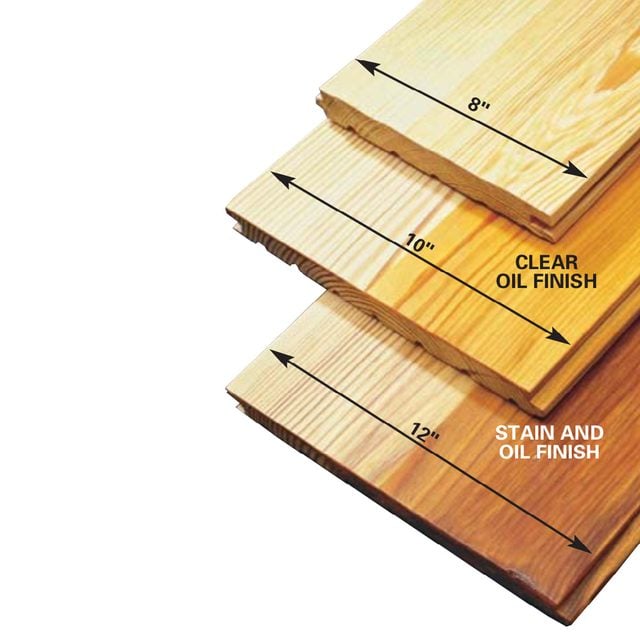
Project step-by-step (21)
Pry up the floor and underlayment

Carefully pry the baseboard and door trim from the wall and set it aside. Then remove the floor covering and underlayment (if you have any) to get to the subfloor. Underlayment is a layer of plywood or particleboard often found under carpet or vinyl. Now is the time to do repair work on the subfloor. Remove the existing floor covering and pry up the underlayment with a pry bar, leaving the subfloor intact. Pull all protruding nails. Walk the floor to check for loose or squeaky spots in the subfloor. To tighten the subfloor, drive 2-in. screws into the joists.
Cut the door jambs
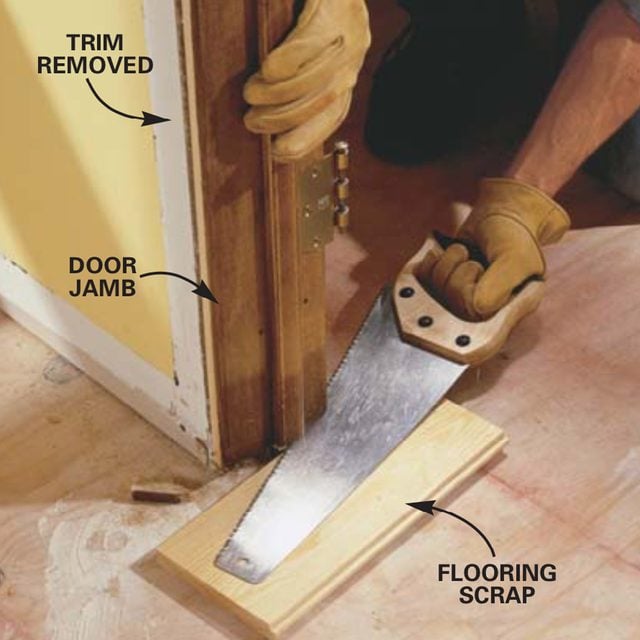
Walk around the room to locate any squeaks. Since the cause of most squeaks is a loose subfloor rubbing up and down against nails, drive wood screws into the joists below to tighten up the subfloor.
Cut out and replace any damaged subfloor. Also look for high spots, especially at seams. If a 4-ft. straightedge shows a 1/8-in. or bigger rise, belt-sand it off with a coarse grit. Use the nail lines to find the location of the floor framing (joists) and mark the walls for reference. Undercut any jambs to allow the new flooring to slide underneath. Undercut the door jambs (and the trim if it’s staying on) with a handsaw. Use a piece of scrap flooring as a height guide; this allows the new flooring to slide underneath. Vacuum the whole floor thoroughly.
Mark the joist locations

Snap chalk lines on the rosin paper following your layout. Mark the joist (floor framing) locations on the wall before rolling out and stapling down the rosin paper. Snap chalk lines to mark the joists and, consulting your layout drawing, snap lines to mark out the flooring board layout.
Cut boards to length

Cut boards to length with a circular saw. Clamp on a guide to ensure square cuts and cut from the back side of the board (to minimize splintering the good side). If you use a sliding miter saw, cut with the good side up.
How to install tongue and groove flooring: Hand nail the first board in place

The chalk line for the first board must be accurate to make sure the first row is straight. Rip to width and align the first board along the first chalk line, tongue out. Predrill and nail along the wall with 8d finish nails driven into every joist. Countersink them 1/8 in. and fill them with a natural color hardening putty. Note: Center the butt joints on the joist layout lines. Rip the first row to width using your circular saw or a table saw. Leave at least a 1/4-in. gap at the wall for wood expansion. Cut the board ends so butt joints (formed by boards that meet end to end) occur over floor joists.
Later you’ll nail each board end into the joist with the decorative cut nails. Be sure to stagger butt joints from row to row so they don’t line up across the floor. Cut the boards to length with a circular saw but keep in mind that perfect cuts aren’t necessary; the ends at walls will be covered by the baseboard and it’s OK if the butt joints show small gaps. If you want to speed up the job, rent a sliding miter saw, especially for the angle cuts around the hearth.
Face-nail the first row close to the wall with either 8d finish nails (predrill to avoid splitting) or an air powered 15-gauge finish nailer to speed up the work. Nail into every joist to keep this row from moving when you tap in the next rows. Set the nails 1/8 in. deep.
Use a power stapler for solid fastening and use a block to tap boards together
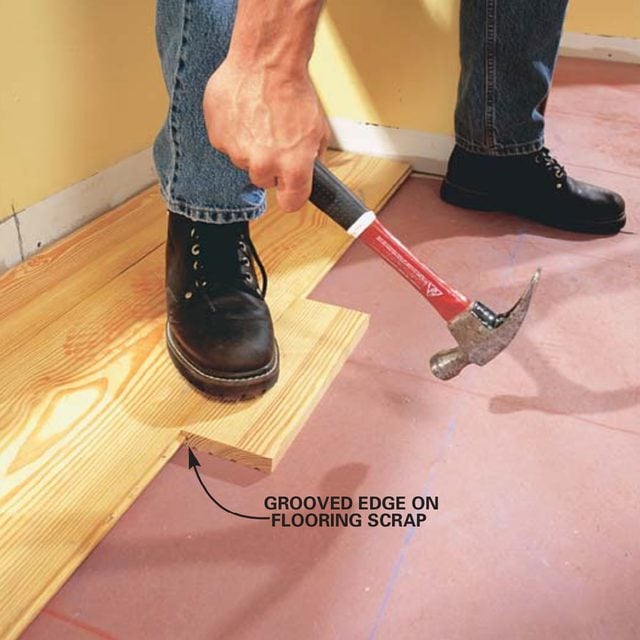
Fit the second board’s groove onto the tongue of the first. Tap with a block (flooring scrap) and hammer to drive the boards together. For an antique look, create a small gap (1/16 in.) between the boards with a removable shim.
How to Lay Hardwood Floor With a Contrasting Border
How to install tongue and groove flooring: Nail the floor every 2 ft.

Insert shims for even gaps, and nail through the tongue of the board with a flooring stapler. Start at one end of the board and work to the other, nailing every 2 ft. After the first row, tap each subsequent row into place and nail with a flooring stapler. Nail every 2 ft. to tack the flooring in place—the decorative cut nails will hold it tight. We chose to create a small (1/16-in.) gap between boards by inserting plastic putty knives before nailing. The gap ensures that each board appears separate and adds to the antique look. Nailing a pine floor is much more forgiving than other flooring, because gaps are part of the look!
Cut boards to fit around corners and notch the boards to fit doorways

Hold the board in place at doorways and corners and mark for notching with a straightedge. The board only needs to fit within 1/4 in. of the wall and slide under the door jamb.
Notch the boards

Transfer the cutout lines to the back of the board and cut out the notch with a jigsaw. Cutting from the back minimizes splintering of the front face. Mark and then cut the board to fit at the door jamb. Cut the notch so that it slides about 1/2 in. under the jamb so the jamb will appear to be completely sitting on the flooring.
Installing tongue and groove flooring: Wedge bowed boards straight

Wedge the boards together if necessary to straighten bowed boards. Cut the wedge from a scrap of flooring with the groove left on. Drive the wedge between the flooring board and a scrap board screwed to the subfloor. Cut badly bowed boards into shorter lengths. Make a wedge to drive slightly bowed boards together. If the gap won’t tighten up, cut the board into shorter lengths.
Installing tongue and groove flooring: Rout grooves in boards to handle special features
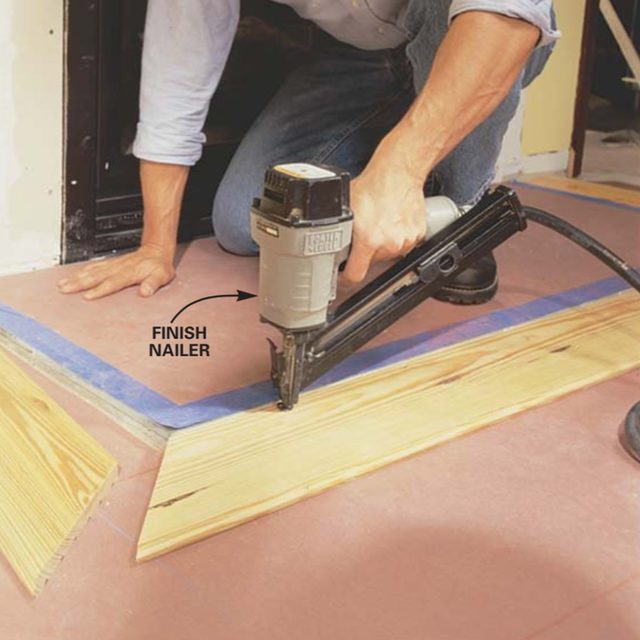
Frame the fireplace hearth with a 6-in. wide board with the tongue facing out. Cut flooring to 6 in. wide to frame around the fireplace hearth. Nail these pieces with the tongue facing out. You’ll groove the next floorboards to fit.
Rout boards to fit the hearth
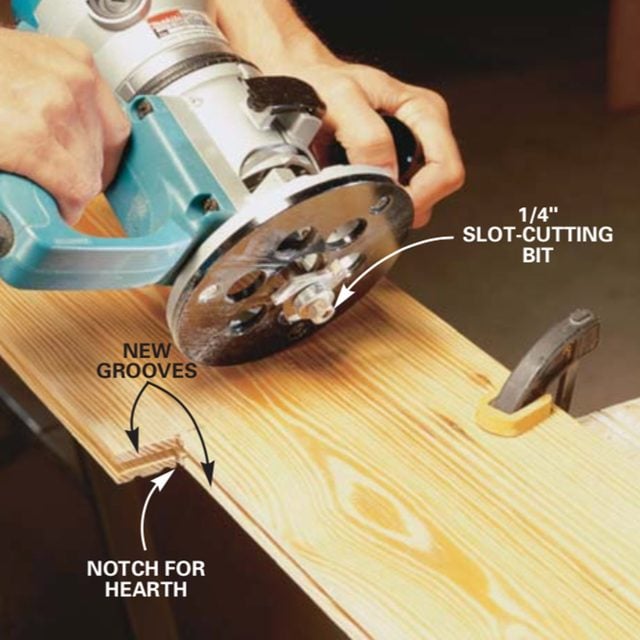
Rout a groove into the edge of this notched board with a slotcutting bit. The groove must line up with the hearth board’s tongue. Clamp the board securely to the horses or a workbench.
Guide to Installing Laminate Flooring
Slot-cutting router bit

Use a router with a 1/4-in. slot-cutting bit to cut a groove into the edge that abuts the fireplace frame. Set the router cutting depth to match the factory cut grooves.
Slide the board along the hearth

You’ll have to notch a floorboard to fit around the frame. Slide and tap this board into place. Slide the notched piece into place. Use a block and hammer if needed to drive the board in. The tongues and grooves will align the boards and hold them flush.
Routing
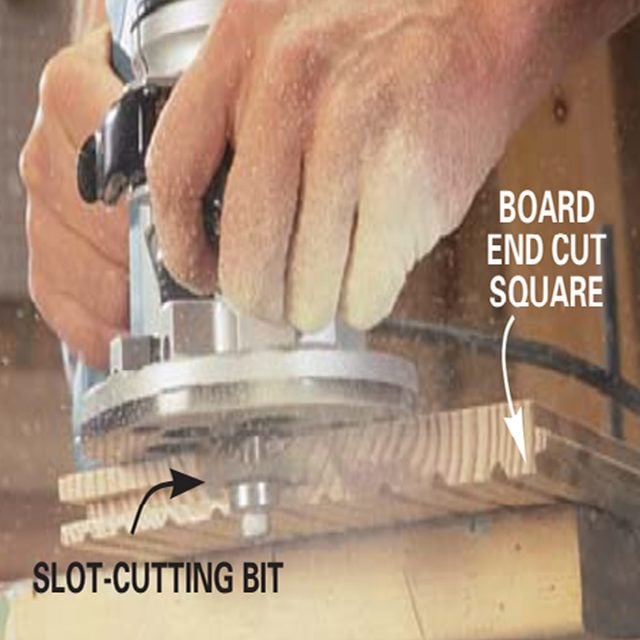
Cut the next board to length and groove the end with the slotting cutter.
How to install tongue and groove flooring: Groove fitting

Fit the board onto the tongue of both the preceding board and the hearth trim board. Continue this process to the other side of the hearth.
Groove the ends of the next few boards that butt into the fireplace frame as well. All this grooving will keep the boards around the fireplace frame flush with one another. Use this same technique where floorboards butt into other flooring materials at doorways.
Craft the final boards to fit snuggly and install the threshold

Undercutting a jamb where the wood meets another flooring material can be tricky. Use a handsaw and a sharp chisel to finish the cut before the last floorboard is installed. Planning is important, and the layout drawing can be invaluable for anticipating difficult fits. Measure, cut and slide the threshold board under the jambs at the doorway before the final floorboard is installed. Cut the final full length boards to width with a table saw and check the fit at the threshold.
Install the final board
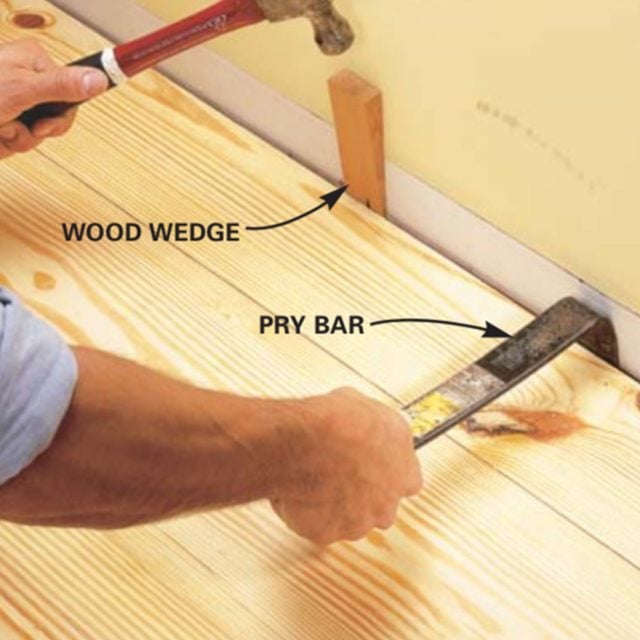
Angle the last board into place and wedge it tight. Cut the final board to width and pry and wedge it into position (allow 1/4 in. between the board and the wall). You may have to put it in at an angle and tap it down. Face nail the board.
Nail the threshold in place

Face-nail the threshold and fill all nail holes with putty. You’ll have to face-nail the last few rows of floorboards and the threshold board, because the flooring nailer won’t fit.
Mark the joists and add style with antique cut nails

Stretch a string line (not a chalk line) to mark the joists. Drill the pilot holes for the cut nails using a simple spacing guide. Hammer the cut nails flush with the pine flooring and countersink 1/8 in. below the surface with a heavy punch or countersink. A traditional plank floor was face-nailed with handmade nails. A 2-1/2-in. masonry cut nail has this look. Mark each joist location with a string line (no chalk!) and drill pilot holes for the cut nails. The hole size should be close to the narrow dimension of the rectangular head of the cut nail. Make a simple guide to space the nails about 1-3/4 in. from the board edge (Photo 18). Two nails are sufficient to hold the 10-in. (9-in. actual) board flat, but a wider board will require three nails. Be sure to set the cut nails 1/8 in. below the surface before starting the finishing steps. When nailing the ends of boards, splitting is a real possibility even with pre-drilling. Don’t worry; minor splitting adds to the antique look.
Rub in an oil finish

Apply a heavy coat of oil with a medium nap paint roller or wool applicator. After 15 minutes apply a second, lighter coat. Allow to soak in for an additional 15 minutes.
Install Prefinished Wood Flooring
Wipe the floor until it’s dry

Wipe until dry; there should be no oil sitting on the surface. Our flooring material required only fine sanding. If you’re not sanding, clean the floor with a cloth dampened with paint thinner. Remove tough dirt or scuff marks with a fine (120-grit) sandpaper. Fill all your countersunk face-nail holes (not the decorative cut nails) with a hardening putty and sand flush with the wood with 120-grit paper. Use putty that closely matches the wood’s color.
Heart pine floors darken slightly with exposure to light and will age gracefully, taking on a unique mellow color. You’ll obscure this natural aging (patina) with stain, but if you want to stain, keep it light. Try a test piece first. Let the stain dry for 24 hours and then apply the oil finish.
Apply a heavy coat of the penetrating oil, let it soak in for 15 minutes and then apply a light coat where it looks dry. After another 15 minutes, wipe the floor dry with clean cloths. Do not leave any wet areas—they’ll become shiny spots. Let the oil dry for 24 hours, buff with 150-grit sandpaper or a sanding screen and apply another light coat. Let sit for 15 minutes and then wipe up, leaving no puddles. Use this same buffing and oiling procedure to maintain your floor through the years. Depending on traffic and wear, oiling needs to be done every three to five years.
Avoid sanding if possible.
Little or no sanding may be required, depending on the quality of the milling. Ask the potential supplier what it recommends for its product. An accurately milled board will have a uniform surface that will accept the stain and/or oil evenly without sanding. Other boards may need to be sanded. Considering the savings in labor, equipment rental, material cost and dust in the house, we recommend spending slightly more for better milled material that you don’t have to sand.
Make sure any professional finisher you hire is experienced with pine floors and fully understands their unique character.
Sanding a Pine Floor

Pine is soft and must be sanded carefully to avoid gouges. The square buff sander worked well because it’s less aggressive than drum sanders. Even a novice can use it with confidence. First sand high spots and rough areas with a portable belt sander (40-grit belt). Then proceed with the square buff sander using the 60-, 80- and 100-grit papers or screens in sequence. Be sure to vacuum between each grit size. You’ll have to do a little hand-sanding at the edges and doorways. Also use the square buff sander with a 150-grit screen between coats of oil or varnish.
